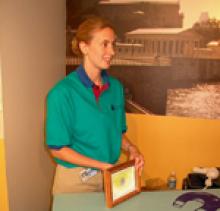
The goal of this activity is to demonstrate how things on a micro scale affect your senses (how you see in this case) on a macro scale.
Mystery Mix Procedure
Materials needed:
- Frame with mixture of iron beads and non-magnetic powder inside
- Strong magnet
- Smaller magnet for visitors
Procedure
Set-up:
- Make sure you have the frame and magnet out.
- Make sure the mixture in the frame is well mixed and the magnet is nowhere near the frame.
During the Demonstration:
- Ask visitors to look at the "stuff" in the frame - ask them what color it is and how many different types of materials are in the frame.
- Then use the magnet to separate the two mixtures. Allow visitors to try it themselves with the smaller magnet. Now ask them again what color the mixture is and how many materials are in the mixture.
Cleanup:
- Gather all materials and return to storage.
Explanation
This is as simple as it seems. The mixture is made of black iron particles and white non-magnetic particles. When mixed together the particles are indistinguishable and the mixture appears gray. However when the magnet is used to separate the iron particles it becomes clear that there are two materials - one white and one black. This introduces the idea that things too small to see can make a difference. All of the other materials we will talk about use the same concept of something on a microscopic scale determining macroscopic properties.
What Could Go Wrong?
Be careful not to scratch the glass of the frame with the magnet.
Make sure the magnet isn't drawn to quickly to the glass the force could, in rare instances, break the glass.
General Maintenance
No issues.
Procedure Sheet: mysterymix_procedure.pdf
Mystery Mix FAQs
The mysterious mixture appears to be made up of one gray substance. When we use a magnet we can separate the mixture into two materials. One is a black iron powder that is attracted to the magnet and the other is a white powdery substance, sand, which you may have seen at the beach!
Cool Facts:
- When you shake up the Mysterious Mixture, it appears gray. Why is that? The individual particles inside the window are too small for your eyes to see individually. So, your eyes "blend" the black and white particles together making you see gray.
- A single grain of sand or iron is very small, too small for you to see with your eyes and is referred to as "microscale". Objects this small can be seen more easily with a microscope.
- Even though you cannot see objects on the microscale, small objects make a difference. An example is bacteria in our bodies that we cannot see. An important part of your health is to maintain healthy bacteria inside of you. There are a large number of bacteria that are critical to the proper digestion of food which live in your intestines.
A: There are many things that you can see with a microscope which are too small to be seen with your eyes alone. If you have access to a microscope, you can see bacteria which live in yogurt.
A: The white powder is silica (very fine sand) and the black powder is iron filings.
A: Iron (the black powder) has a special property called ferromagnetism that makes it attracted to the magnet in your hand. Silica (the white powder) is not attracted a magnet (like most things!) so the two can be separated.
A: Both the iron and the silica powders are about 60 micrometers ( m m) - the same as the average diameter of a human hair. (60 m m)
A: No reason. The background is colored only to make it easier to see both of the powders.
On a smaller scale things can behave differently and are very important. Bacteria in our bodies help us to digest our food even though we cannot see them. Also, these small things collectively can exhibit larger properties too. A single grain of sand cannot be seen with our eyes but at the beach, we easily see the sand.

